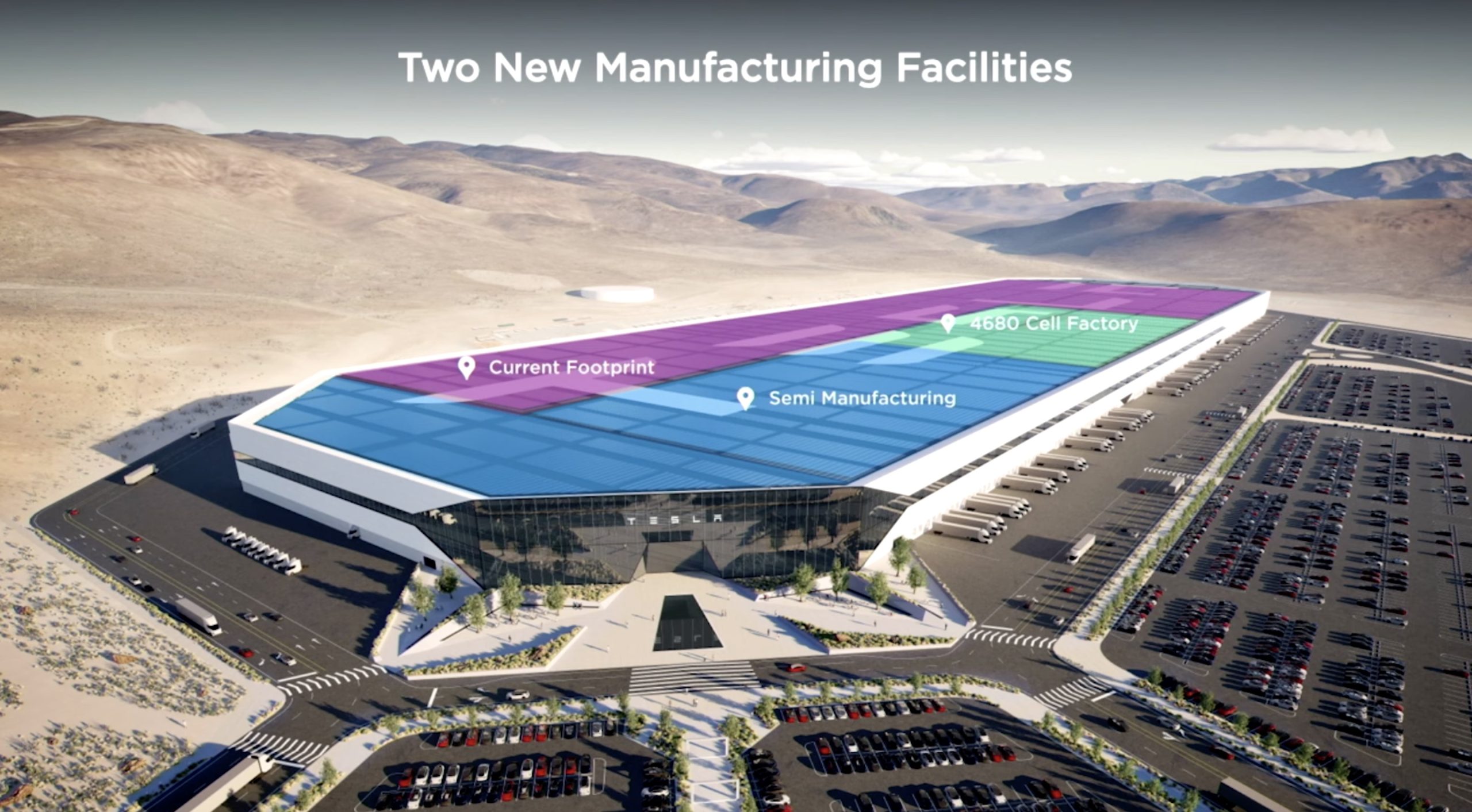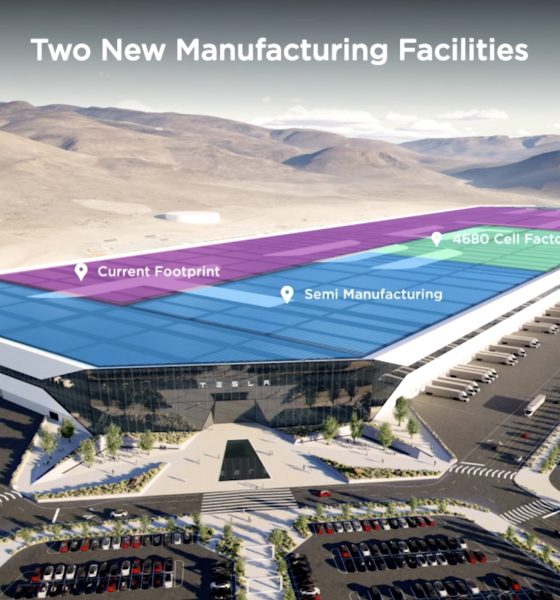The Nevada Governor’s Office of Economic Development (GOED) Board approved a $330,250,366 million tax break for Tesla. The state board approved the abatement considering Tesla’s plans to invest $3.6 billion to expand Gigafactory Nevada in Storey County.
The GOED Board calculated that Tesla’s $3.6B capital investment in Giga Nevada could generate an estimated $685 million in net state and local revenues in the next 20 years. Listed below are the taxes Tesla could generate, assuming it invests all $3.6 billion in land, buildings, and equipment for Giga Nevada.
- Up to $21.8 million in gross average annual property tax revenues
- $11.2 million in gross average annual sales taxes
- $1.1 million in average annual business license taxes on utilities
- $2.1 million in gross average annual modified business taxes.
Tesla is due to pay an annual minimum of $53 million in real and personal property taxes and modified business taxes related to Giga Nevada starting July 1, 2024, and in perpetuity thereafter. The $53 million in taxes was part of Tesla’s first abatement agreement with the state in 2014.
“Tesla has far exceeded every promise they made going back to 2014,” said Governor Joe Lombardo, who chairs the GOED Board. “To date, they have invested $6.2 billion in Nevada, built a 5.4 million square foot Gigafactory which provided 17,000 local construction jobs and created more than 11,000 highly paid permanent jobs.”
Giga Nevada Expansion Plans
In January 2023, Tesla announced expansion plans for Giga Nevada. The expansion includes 4 million square feet of new manufacturing footprint, 3,000 new jobs, and 2 new manufacturing facilities.
One of the new facilities is a 100 GWh cell factory dedicated to Tesla’s 4680 battery. The other manufacturing facility will be Tesla’s Semi factory.
Nevada’s 4680 Assembly Line
Tesla’s 100 GWh battery cell factory in Nevada is expected to have the capacity to produce enough batteries for 1.5 million light-duty vehicles annually. During a previous TSLA earnings call, Andrew Baglino noted that some of the 4680 cells made in Nevada will go into Semi trucks.
Tesla CEO Elon Musk hinted that the other 4680 cells from Giga Nevada would go to Tesla’s future vehicles equipped with the company’s next-gen platform. During Investor Day 2023, Musk announced that Tesla’s upcoming Gigafactory Mexico would produce the first of the company’s next-gen vehicles.
“Since the inception of GOED, the main goal has been to diversify Nevada’s economy,” said Tom Burns, GOED Executive Director.
“The Nevada-Tesla partnership cemented a new economic sector in Nevada for the manufacturing of electric vehicle battery packs and drive units, and energy storage products. Tesla’s Gigafactory propelled Nevada’s manufacturing industry, establishing lithium-ion batteries as the state’s eighth largest export both nationally and internationally,” Burns added.
The Teslarati team would appreciate hearing from you. If you have any tips, contact me at maria@teslarati.com or via Twitter @Writer_01001101.

News
Tesla FSD fleet is nearing 7 billion total miles, including 2.5 billion city miles
As can be seen on Tesla’s official FSD webpage, vehicles equipped with the system have now navigated over 6.99 billion miles.

Tesla’s Full Self-Driving (Supervised) fleet is closing in on almost 7 billion total miles driven, as per data posted by the company on its official FSD webpage.
These figures hint at the massive scale of data fueling Tesla’s rapid FSD improvements, which have been quite notable as of late.
FSD mileage milestones
As can be seen on Tesla’s official FSD webpage, vehicles equipped with the system have now navigated over 6.99 billion miles. Tesla owner and avid FSD tester Whole Mars Catalog also shared a screenshot indicating that from the nearly 7 billion miles traveled by the FSD fleet, more than 2.5 billion miles were driven inside cities.
City miles are particularly valuable for complex urban scenarios like unprotected turns, pedestrian interactions, and traffic lights. This is also the difference-maker for FSD, as only complex solutions, such as Waymo’s self-driving taxis, operate similarly on inner-city streets. And even then, incidents such as the San Francisco blackouts have proven challenging for sensor-rich vehicles like Waymos.
Tesla’s data edge
Tesla has a number of advantages in the autonomous vehicle sector, one of which is the size of its fleet and the number of vehicles training FSD on real-world roads. Tesla’s nearly 7 billion FSD miles then allow the company to roll out updates that make its vehicles behave like they are being driven by experienced drivers, even if they are operating on their own.
So notable are Tesla’s improvements to FSD that NVIDIA Director of Robotics Jim Fan, after experiencing FSD v14, noted that the system is the first AI that passes what he described as a “Physical Turing Test.”
“Despite knowing exactly how robot learning works, I still find it magical watching the steering wheel turn by itself. First it feels surreal, next it becomes routine. Then, like the smartphone, taking it away actively hurts. This is how humanity gets rewired and glued to god-like technologies,” Fan wrote in a post on X.
News
Tesla starts showing how FSD will change lives in Europe
Local officials tested the system on narrow country roads and were impressed by FSD’s smooth, human-like driving, with some calling the service a game-changer for everyday life in areas that are far from urban centers.

Tesla has launched Europe’s first public shuttle service using Full Self-Driving (Supervised) in the rural Eifelkreis Bitburg-Prüm region of Germany, demonstrating how the technology can restore independence and mobility for people who struggle with limited transport options.
Local officials tested the system on narrow country roads and were impressed by FSD’s smooth, human-like driving, with some calling the service a game-changer for everyday life in areas that are far from urban centers.
Officials see real impact on rural residents
Arzfeld Mayor Johannes Kuhl and District Administrator Andreas Kruppert personally tested the Tesla shuttle service. This allowed them to see just how well FSD navigated winding lanes and rural roads confidently. Kruppert said, “Autonomous driving sounds like science fiction to many, but we simply see here that it works totally well in rural regions too.” Kuhl, for his part, also noted that FSD “feels like a very experienced driver.”
The pilot complements the area’s “Citizen Bus” program, which provides on-demand rides for elderly residents who can no longer drive themselves. Tesla Europe shared a video of a demonstration of the service, highlighting how FSD gives people their freedom back, even in places where public transport is not as prevalent.
What the Ministry for Economic Affairs and Transport says
Rhineland-Palatinate’s Minister Daniela Schmitt supported the project, praising the collaboration that made this “first of its kind in Europe” possible. As per the ministry, the rural rollout for the service shows FSD’s potential beyond major cities, and it delivers tangible benefits like grocery runs, doctor visits, and social connections for isolated residents.
“Reliable and flexible mobility is especially vital in rural areas. With the launch of a shuttle service using self-driving vehicles (FSD supervised) by Tesla in the Eifelkreis Bitburg-Prüm, an innovative pilot project is now getting underway that complements local community bus services. It is the first project of its kind in Europe.
“The result is a real gain for rural mobility: greater accessibility, more flexibility and tangible benefits for everyday life. A strong signal for innovation, cooperation and future-oriented mobility beyond urban centers,” the ministry wrote in a LinkedIn post.
News
Tesla China quietly posts Robotaxi-related job listing
Tesla China is currently seeking a Low Voltage Electrical Engineer to work on circuit board design for the company’s autonomous vehicles.

Tesla has posted a new job listing in Shanghai explicitly tied to its Robotaxi program, fueling speculation that the company is preparing to launch its dedicated autonomous ride-hailing service in China.
As noted in the listing, Tesla China is currently seeking a Low Voltage Electrical Engineer to work on circuit board design for the company’s autonomous vehicles.
Robotaxi-specific role
The listing, which was shared on social media platform X by industry watcher @tslaming, suggested that Tesla China is looking to fill the role urgently. The job listing itself specifically mentions that the person hired for the role will be working on the Low Voltage Hardware team, which would design the circuit boards that would serve as the nervous system of the Robotaxi.
Key tasks for the role, as indicated in the job listing, include collaboration with PCB layout, firmware, mechanical, program management, and validation teams, among other responsibilities. The role is based in Shanghai.
China Robotaxi launch
China represents a massive potential market for robotaxis, with its dense urban centers and supportive policies in select cities. Tesla has limited permission to roll out FSD in the country, though despite this, its vehicles have been hailed as among the best in the market when it comes to autonomous features. So far, at least, it appears that China supports Tesla’s FSD and Robotaxi rollout.
This was hinted at in November, when Tesla brought the Cybercab to the 8th China International Import Expo (CIIE) in Shanghai, marking the first time that the autonomous two-seater was brought to the Asia-Pacific region. The vehicle, despite not having a release date in China, received a significant amount of interest among the event’s attendees.










